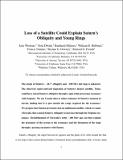Loss of a satellite could explain Saturn’s obliquity and young rings
Author(s)
Wisdom, Jack; Dbouk, Rola; Militzer, Burkhard; Hubbard, William B; Nimmo, Francis; Downey, Brynna G; French, Richard G; ... Show more Show less
DownloadAccepted version (998.2Kb)
Open Access Policy
Open Access Policy
Creative Commons Attribution-Noncommercial-Share Alike
Terms of use
Metadata
Show full item recordAbstract
<jats:p>The origin of Saturn’s ~26.7° obliquity and ~100-million-year-old rings is unknown. The observed rapid outward migration of Saturn’s largest satellite, Titan, could have raised Saturn’s obliquity through a spin-orbit precession resonance with Neptune. We use Cassini data to refine estimates of Saturn’s moment of inertia, finding that it is just outside the range required for the resonance. We propose that Saturn previously had an additional satellite, which we name Chrysalis, that caused Saturn’s obliquity to increase through the Neptune resonance. Destabilization of Chrysalis’s orbit ~100 million years ago can then explain the proximity of the system to the resonance and the formation of the rings through a grazing encounter with Saturn.</jats:p>
Date issued
2022Department
Massachusetts Institute of Technology. Department of Earth, Atmospheric, and Planetary SciencesJournal
Science
Publisher
American Association for the Advancement of Science (AAAS)
Citation
Wisdom, Jack, Dbouk, Rola, Militzer, Burkhard, Hubbard, William B, Nimmo, Francis et al. 2022. "Loss of a satellite could explain Saturn’s obliquity and young rings." Science, 377 (6612).
Version: Author's final manuscript